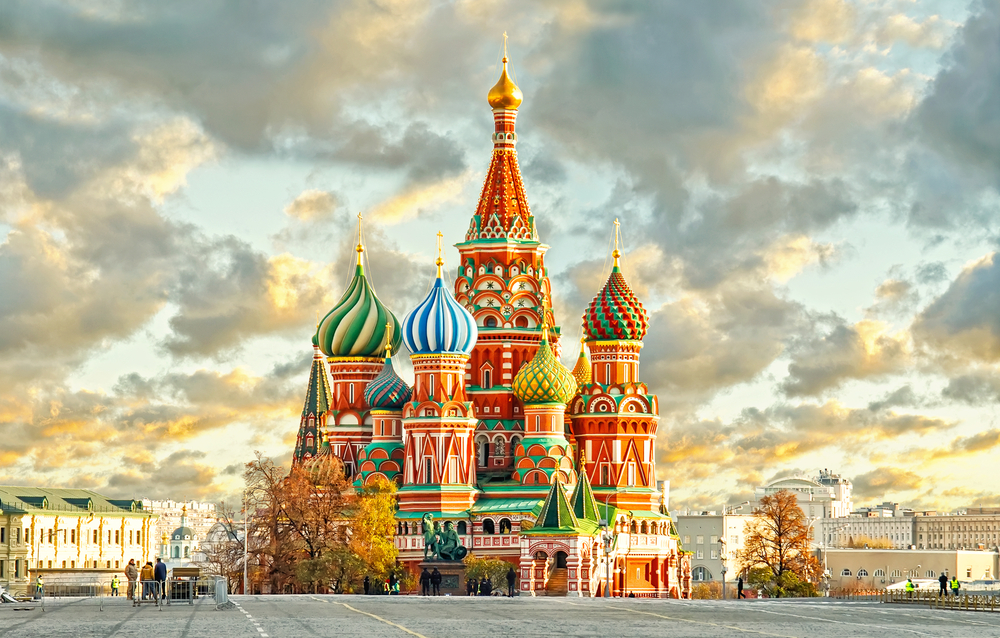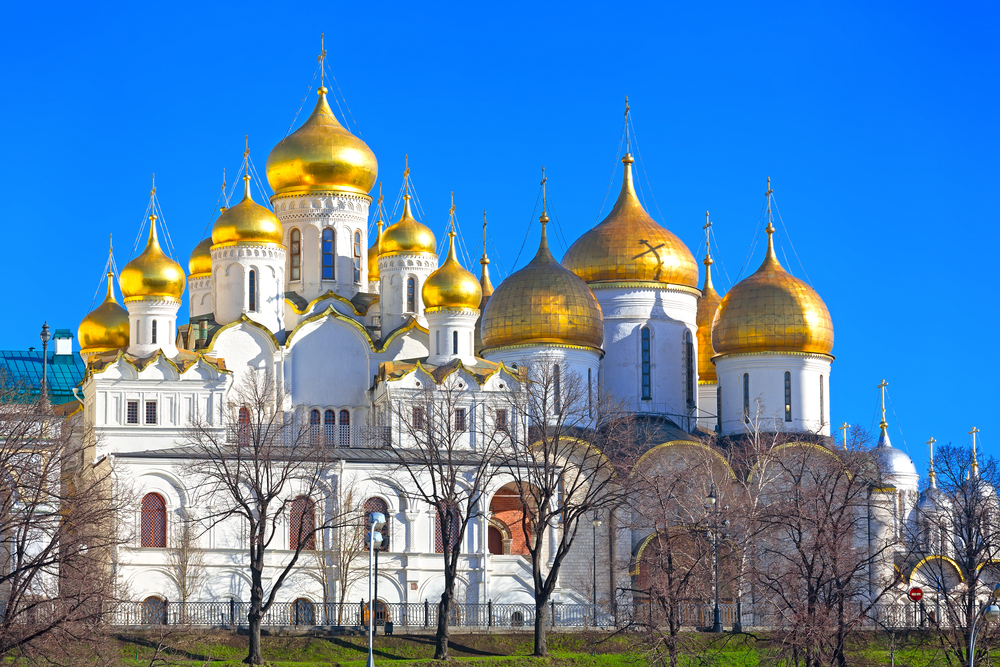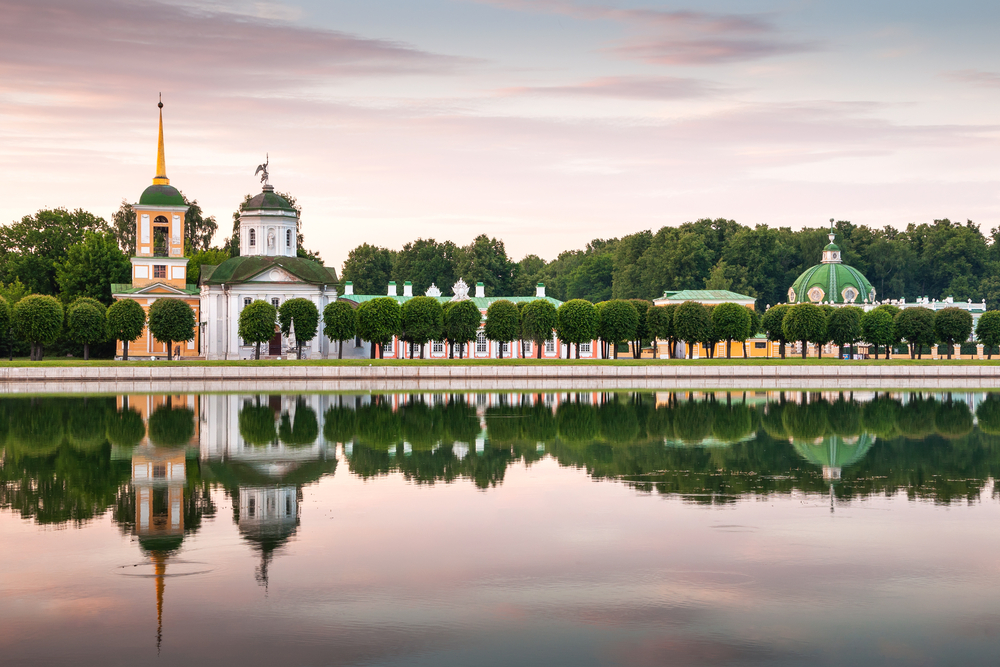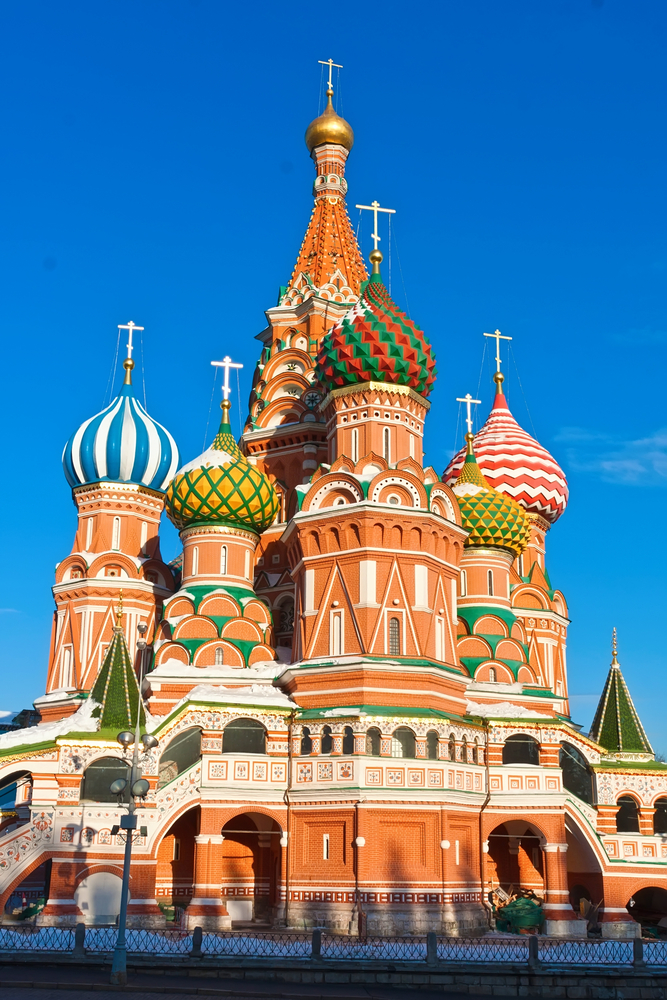Moscow is an amazing city where manours of the nobility harmonically blend with the Stalinist Empire style and ancient monasteries with industrial architecture. What are the must-see Moscow sites?
The Moscow Kremlin

This is the place where Moscow was founded and is almost 9 centuries ago. In the Middle Age, the fortress served as the residence of the Russian sovereigns. Succession is kept. Presently, it is the residence of the President of Russia.
The rampant walls and towers made of red bricks hide authentic cathedrals of the 15th – 17th centuries (architectural complex of the Cathedral Square) as well as interesting museums. The most of them is Armoury Chamber, a unique treasury where imperial regalia, jewelry, weapons, and masterpieces of ornamental arts of the 14th – 19th centuries are kept.
It is worth visiting the Assumption Cathedral (where the Russian Tsars were crowned), the Archangel’s Cathedral (the burial place of Russian Tsars), the Annunciation Cathedral (the Royal home church), ancient premises of the Patriarch’s Palace, and climbing the Ivan the Great Bell-Tower from where an impressive view opens. Don’t miss the Tsar Bell and the Tsar-Cannon that amazes one with their size.
Tickets to the Kremlin sightseeing attractions need to be purchased separately as no combined ticket exists. The museum’s ticket offices are located at Alexander Garden. Before the visit, large hand-luggage must be left at the storage office (located nearby). While waiting for your guide, take a walk along Alexander Garden under the Kremlin walls and is free of charge.
Visiting the Cathedral Square:
Monday-Sunday (closed on Thursdays): 10:00-17:00 From May 15 till September 30: 09:30-18:00
A combined ticket to all the cathedrals, the Patriarch’s Palace and some exhibitions (the list of exhibitions to be clarified at the ticket-office): 500 roubles
Visiting the Armoury Chamber
Monday-Sunday (closed on Thursdays): 10:00-18:00, admissions at 10:00, 12:00, 14:30, 16:30. Tickets can be purchased online or at the ticket offices at Alexander Garden which is 45 minutes before the visit.
Entry ticket: 700 roubles.
Climbing the Ivan the Great Bell-Tower:
Monday-Sunday (closed on Thursdays): admissions at 10:15, 11:15, 13:00, 14:00, 15:00, 16:00. From May 15 till September 30 – additional admission at 17:00. In the winter season, the Bell-Tower is closed. In autumn and spring, attendance can be possible depending on the weather.
Entry ticket: 250 roubles.
The Red Square

It is the main country square where the parade is staged. Tsars’ orders used to be announced here and it is now a place for the parade. Here you can see Saint Basil’s Cathedral – one of the most beautiful in Moscow (the XVI century edifice with 9 coloured domes looks very festive); the State Historical Museum; Lenin’s Mausoleum and the State Department Store (GUM) designed in a pseudo-Russian style (year 1893) that deserves a visit even if you are not planning for shopping. From both sides of GUM, the Red Square is adjoined by ancient streets Ilyinka and Nikolskaya which you can continue your pleasant walk around the historical center. From the square, you can descend to the Moskva-River embankment, or climb the Bolshoy Moskvoretsky Bridge for a beautiful view on the Kremlin opens.
The Arbat
This is the main pedestrian street of Moscow with endless restaurants and souvenir shops. Most buildings dated from the end of XIX – beginning of XX century. The atmosphere of this bohemian street was praised by many writers and poets who often lived here. The Arbat is still charming – young people come here for an evening walk and one can listen to street musicians almost at every corner. At the beginning of the Arbat there is the famous restaurant “Prague“.
Moscow Metro
This is a city that is not only fast and convenient in terms of transport but has a real underground museum. Many stations with high ceilings, luxury marble, bronze, and granite decorations looks like halls of royal palace. One can hardly find two stations that are the same. The most beautiful stations are the Koltsevaya Line (Circle Line), as well as the Arbatsko–Pokrovskaya Line and Zamoskvoretskaya Line inside the Circle Line. The best way to get familiarized with the metro is to go along the mentioned lines that descend at every station. Must-see stations include Ploshchad Revolyutsii (Revolution Square) (Arbatsko–Pokrovskaya Line) with 76 sculptures depicting Soviet people; huge in its size Komsomolskaya (Circle Line) with luxury decorations and patriotic mosaics, Novoslobodskaya (Circle Line) with bright stained-glass panels, and Mayakovskaya (Zamoskvoretskaya Line) with laconic art deco style design.
Bolshoi Theater and its surroundings

The Bolshoi Theatre had been burnt and rebuilt many times and is still one of the most prestigious opera and ballet theatres in the world. Many Russian and world performers starred on its stage. Recently, the Neo-Classism style building (by architects Joseph Bové and Domenico Gilardi) took a large-scale renovation of which the result is accepted by few Moscow people. The best place to admire the theatre is from the opposite side of the huge Theatre (or Teatralnaya) Square. The surrounding streets are the real “theatre heart” of Moscow and a number of young but popular theatres are located there. To search for bohemian atmosphere, it is nice to have a walk down the nearby streets – Bolshaya Dmitrovka and Kamergersky Lane.
Tretyakov Gallery at Lavrushinsky Lane
A cosy museum that accommodates a huge collection of Russian paintings from the 11th to the 20th century and the evolution can be observed while moving from one hall to another. The names of the artists speak for themselves: Repin, Polenov, Shishkin, Vastnetsov, Kramskoy, Levitan, Vrubel, and many others… The exhibition of old Russian icons and pictures by painters of the last half of the 19th century are most notable. Their paintings vividly show the colour of life in the Russian Empire, the beauty of mysterious “unknown women” and modest charm of the Russian nature. The Gallery also has a branch at Krymsky Val dedicated to modern art.
Visiting Tretyakov Gallery at Lavrushinsky Lane
Tuesday, Wednesday, Sunday – 10:00-18:00 (ticket offices and entrance till 17:00).
Thursday, Friday, Saturday – 10:00-21:00 (ticket offices and entrance till 20:00).
Close on Mondays.
Entry ticket: 400 roubles.
Tverskaya Street and its surroundings
It has been the main Moscow street for a long time and is said to be the most expensive, which generally refers to its boutiques and hotels. However, among the restaurants come the budget options that can still be found. One of the centres of the metropolitan life and the place where lovers arrange dates is Pushkin Square in the middle of Tverskaya Street. Tverskaya atreet is built-up with proud edifices in Stalinist Empire style and pedestrians look like Lilliputs against their background. It is certain that the opposite picture can be seen and is located to the south from Bolshaya Nikitskaya, a charming street with low 18th – 19th century buildings that is occupied in the evening by theatre goers and classical music amateurs who hurriedly finish their coffee at small cafés before submerging to the world of art.
Kuznetsky Most Street
This street has since the old days being known as “the sanctum of fashion” and still keeps this name. Expensive boutiques of famous brands can be found side by side with equally expensive, but much more daring shop-windows of Russian designers, fashionable cafés and bars. The survived edifices of the 19th – 20th centuries that used to belong to luxury trade houses, banks or simply rich Moscow people who leased them out, have been carefully restored and delight the eyes of Moscow antiquity lovers. It is a pedestrian street, so you will not have to shy away from agile Moscow cars while carrying huge shopping bags.
The Moscow State University and the Observation Platform on Vorobyovy Gory

Looking at this building, it is easy to imagine the exaltation of a student who chanced to learn there. An elegant in spite of its huge size (240 m high including the spire) building in Stalinist Empire style is a part of the complex of the main country university. It accommodates several faculties as well as a dormitory for graduate and post-graduate student and teachers. Tourists unfortunately are not allowed to enter, but they can take a walk outside the University and visit observation platform on Vorobyovy Gory (Sparrow Hills) to admire an eye-catching view of the city. On weekend evenings, the spot attracts a colorful crowd of bikers and lovers of illegal races and becomes a little bit noisy.
Novodevichy Convent
One of the most beautiful cloisters of Moscow, whose architectural complex of the 16th – 17th centuries in the Muscovite baroque style has remained virtually intact and proclaimed a UNESCO World Heritage Site. Light and laced building are amazingly photogenic. It used to be a place of exile for unwanted wives and sisters of Russian Tsars, and many noble women became nuns of the convent voluntarily contributing their valuables on going into a convent. No surprise that soon after the convent has become one of the richest in Moscow. The convent is still functioning. Many cultural figures of Russia starting from the XIX century and up to present days are buried in the territory of the convent and located nearby Novodevichy Cemetery. Many tombstones are outstanding works of art.
Visiting Novodevichy Convent:
Daily 9:00-17:00
Entry ticket: 300 roubles.
Park and Estate Kuskovo
The luxury former estate of one of the richest Russian noble families – the Sheremetyevs – is sometimes called “the Moscow Versailles”. Unlike many estates of noble families destroyed during the Revolution, Kuskovo has remained practically intact. Making a visit to the palace with elegant interiors and the huge XVIII century park with numerous sculptures, guest houses and pavilions it is possible to learn about the life of the “upper crust” of the Emperor Russia of those times. The atmosphere of luxury is added by a collection of porcelain and art glass that looks especially organic here.
Visiting the Park and Estate Kuskovo:
Open on Wednesdays-Sundays; closed on Mondays, Tuesdays and the last Wednesday of the month.
The Palace, the Grotto, the Italian and the Dutch Houses: 10:00-16:00
The park, the Hermitage and orangeries with collections of porcelain and art glass: 10:00-18:00 (ticket offices close at 17:30)
Tickets to each object shall be purchased separately: the Park – 40 roubles, the Palace – 150 roubles (without exhibitions), each Orangerie – 150 roubles, each house in the Park – 50 roubles, the Hermitage with temporary exhibitions – 100 roubles, the Grotto – 100 roubles.
Boulevard Ring
The best way to feel the atmosphere of old Moscow is to make a relaxed walk along the Boulevard Ring. In spite of the name, this is not a ring but a semi-ring of calm ancient boulevards and squares in the very center of Moscow about 9 km long, from the Cathedral of Christ the Saviour to the Yauza River. Sometimes on the way there are nice restaurants, theaters and museums, and the Ring is crossed by busier streets, but anyway it seems that the time has practically stopped here. Young people like to walk in this “non-tourist” place in the evening, and the boulevards often become the location of free open air photo exhibitions.